Imagine this: You’ve spent weeks crafting the perfect email newsletter, filled with engaging content, eye-catching visuals, and a call to action you’re sure will drive conversions. You hit send. But instead of the results you were hoping for, your open rates are lackluster, engagement is non-existent, and your hard work seems to have vanished into the inbox abyss. Sound familiar?
The truth is, a great newsletter needs more than good content—it needs the right platform. Whether you’re a small business owner, a SaaS company, or a content creator, choosing the right newsletter platform in 2024 can transform how you connect with your audience.
In this guide, we’ve rounded up the Top 9 Newsletter Platforms for 2024, breaking down their features, pricing, and ease of use. From hidden gems to industry favorites, we’ve got everything you need to make an informed decision and take your email game to the next level.
Quick List of Top #9 Newsletter Platforms
#1 MailerLite
#2 Kit
#3 Sender
#4 Flodesk
#5 Moosend
#6 Ghost
#7 Substack
#8 Mailmodo
#9 Aweber
Key Factors to Consider When Choosing a Newsletter Platform
Choosing a newsletter platform is more than just picking a popular name. The right choice depends on your specific needs, audience size, and marketing goals. Here are the key factors to consider when selecting the best newsletter platform for your business in 2024:
Ease of Use
Let’s be honest—no one has time to wrestle with complicated software. A platform should offer a user-friendly interface, especially for those who aren’t tech-savvy. Drag-and-drop editors, pre-designed templates, and an intuitive layout can save you hours of time. Look for platforms that let you design, schedule, and analyze emails with minimal effort.
Pro Tip: Some platforms cater specifically to beginners, while others offer advanced tools for marketers who want full control over customization. Identify where you fall on that spectrum.
Key Features
The core features of a newsletter platform are what set it apart. Automation, segmentation, and analytics are non-negotiable in today’s email marketing world. But beyond these essentials, you should consider:
- Advanced Personalization: Can you tailor content based on customer behavior?
- A/B Testing: Does the platform allow you to experiment with different subject lines, content, or designs to find what works best?
- Integrations: Can you connect it easily with your CRM, eCommerce platform, or other marketing tools?
Hidden Gem: Some platforms offer unique features, such as AI-driven content recommendations or real-time collaboration for teams working on email campaigns. These often get overlooked but can supercharge your marketing efforts.
Pricing
Budget always matters. Newsletter platforms typically offer tiered pricing, which can range from free plans (with limited features) to high-tier packages aimed at larger businesses. Pay attention not only to the monthly costs but also to additional charges, such as:
- Overages for exceeding subscriber limits.
- Charges for extra features like SMS integration or premium templates.
Insider Tip: Many platforms offer a generous free plan or a free trial—take advantage of those before committing. Some also have discounts for non-profits or yearly subscriptions.
Support & Security
Ever been in the middle of a time-sensitive campaign and had something go wrong? The speed and quality of customer support can make or break your experience. Look for platforms that offer:
- 24/7 support (preferably with live chat or phone support).
- A comprehensive knowledge base or community forum.
On the security front, you’ll want to ensure the platform complies with data protection standards like GDPR and offers tools like two-factor authentication.
Scalability
Are you planning to grow? Then your email platform needs to grow with you. Consider platforms that can handle a large increase in subscribers and offer features to scale, such as:
- Support for larger email lists.
- Advanced automation workflows.
- Integration with larger CRM systems.
Bonus Tip: Some platforms charge based on the number of emails sent, while others charge based on the number of subscribers. Depending on your audience size and sending frequency, one model might save you more money.
#1 MailerLite
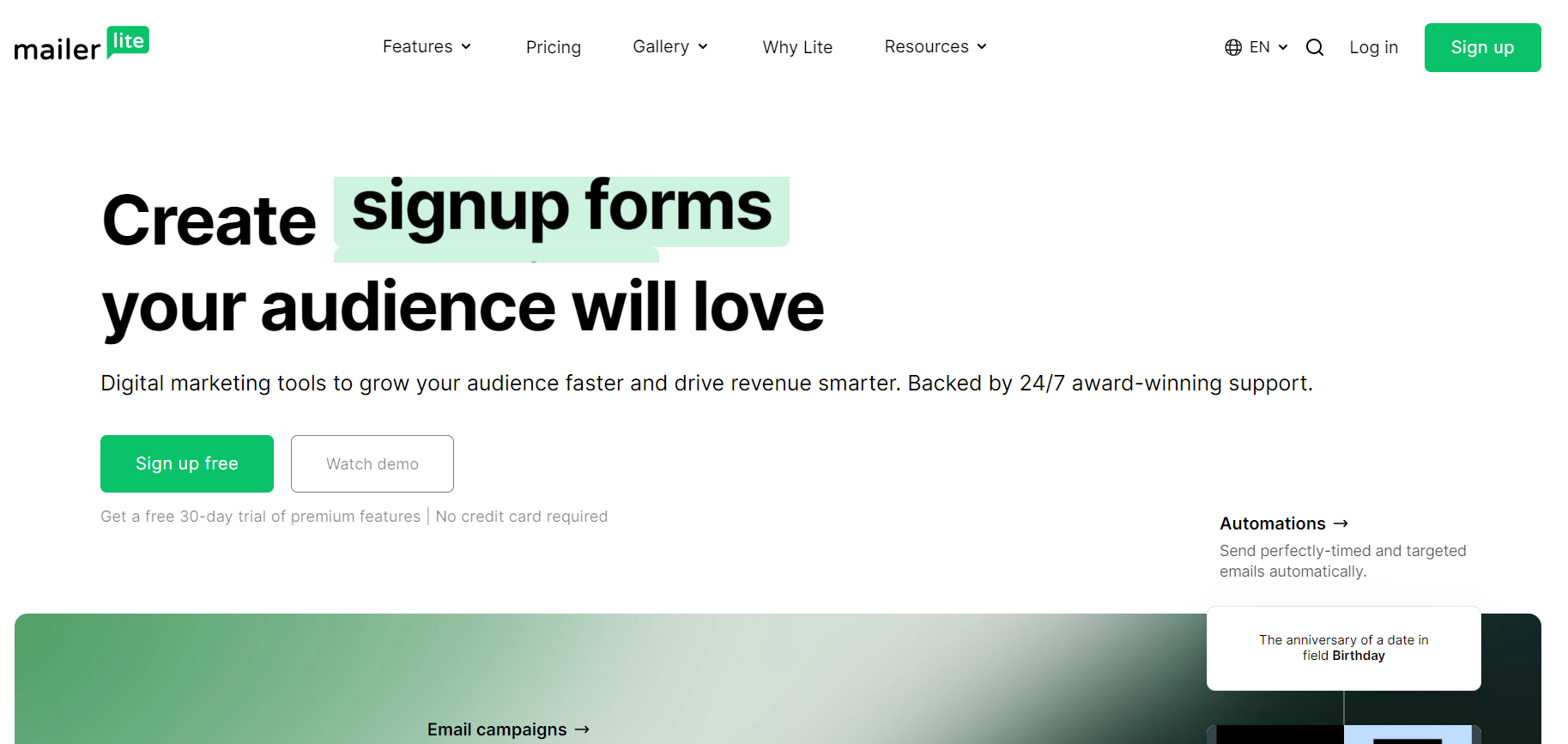
MailerLite strikes the perfect balance between ease of use and powerful features, making it an ideal choice for businesses of all sizes, especially those looking to scale their email marketing in 2024. Whether you’re just starting with email campaigns or need more advanced tools to streamline your efforts, MailerLite offers a versatile solution.
Its user-friendly interface ensures even beginners can design stunning newsletters, while its automation and segmentation tools provide seasoned marketers the flexibility to create targeted, personalized campaigns. This blend of simplicity and functionality has made MailerLite a go-to platform for marketers aiming to grow their subscriber base and drive engagement without breaking the bank.
Key Features
- Drag-and-Drop Editor: Quickly create professional emails with customizable templates.
- Automation: Set up automated workflows, from welcome emails to cart abandonment follow-ups.
- Segmentation: Target the right audience based on behavior, location, or preferences.
- Landing Pages & Pop-ups: Built-in tools to capture leads without needing extra software.
Unique Feature: The subject line tester helps you optimize your open rates by predicting how effective your subject lines will be.
Pricing
- Free Plan: Up to 1,000 subscribers and 12,000 emails per month.
- Paid Plans: Start at $10/month for unlimited emails and advanced features.
Ease of Use
With an intuitive interface, MailerLite is great for beginners but also offers enough features for experienced marketers.
Pros & Cons
Pros:
- Simple interface with no steep learning curve.
- Generous free plan.
- Built-in landing page and pop-up features.
Cons:
- Advanced users may find the automation options limited.
- Customer support can be slower for free plan users.
#2 Kit
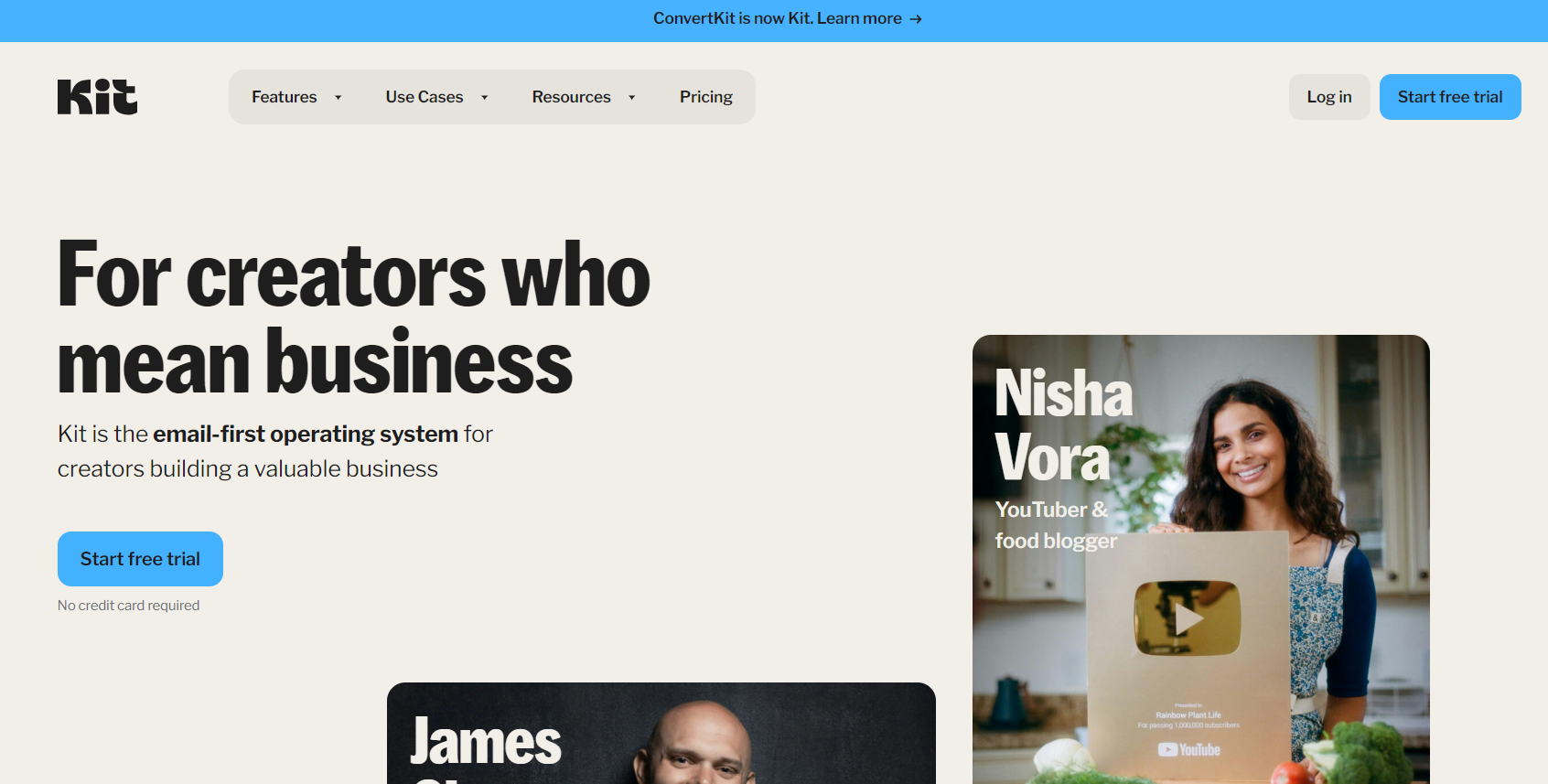
Kit is quickly emerging as a game-changer in the email marketing world, especially for businesses that want to leverage AI for deeper personalization and smarter automation. As one of the most innovative platforms on the market in 2024, Kit’s strength lies in its ability to help marketers create tailored email campaigns with minimal effort.
Key Features
- AI-Driven Personalization: Kit’s standout feature is its AI-powered content recommendations. The platform analyzes user behavior and preferences to suggest personalized content, ensuring each recipient gets emails relevant to their interests.
- Automation with AI: Kit doesn’t just automate tasks—it automates intelligently. The platform learns from your audience’s actions and helps optimize sending times, subject lines, and content for better engagement.
- Visual Builder: Kit offers a drag-and-drop visual editor, making it easy to design emails without needing design skills.
- Pre-built Automation Templates: For businesses short on time, Kit includes templates for automated workflows like welcome sequences and abandoned cart reminders, all optimized with AI suggestions.
Unique Feature: Kit’s AI-powered insights stand out from traditional email analytics. It can predict engagement trends and suggest changes to boost future campaign performance, a feature most platforms lack.
Pricing
Kit’s pricing is flexible, offering plans that scale with your business:
- Free Plan: Available for up to 500 subscribers, with access to essential features.
- Paid Plans: Start at $15/month, with advanced AI-driven tools and unlimited emails.
Ease of Use
While Kit is powered by sophisticated AI, its interface is designed to be simple. Even marketers who are new to AI-driven tools will find it easy to navigate, thanks to its clean layout and step-by-step guides.
Pros & Cons
Pros:
- AI-driven personalization for more targeted campaigns.
- Predictive analytics that improve over time.
- Easy-to-use interface with advanced automation.
Cons:
- Kit is newer to the market, so its feature set may not be as extensive as some competitors.
- Its AI-based features may feel overwhelming for those used to manual control.
#3 Sender
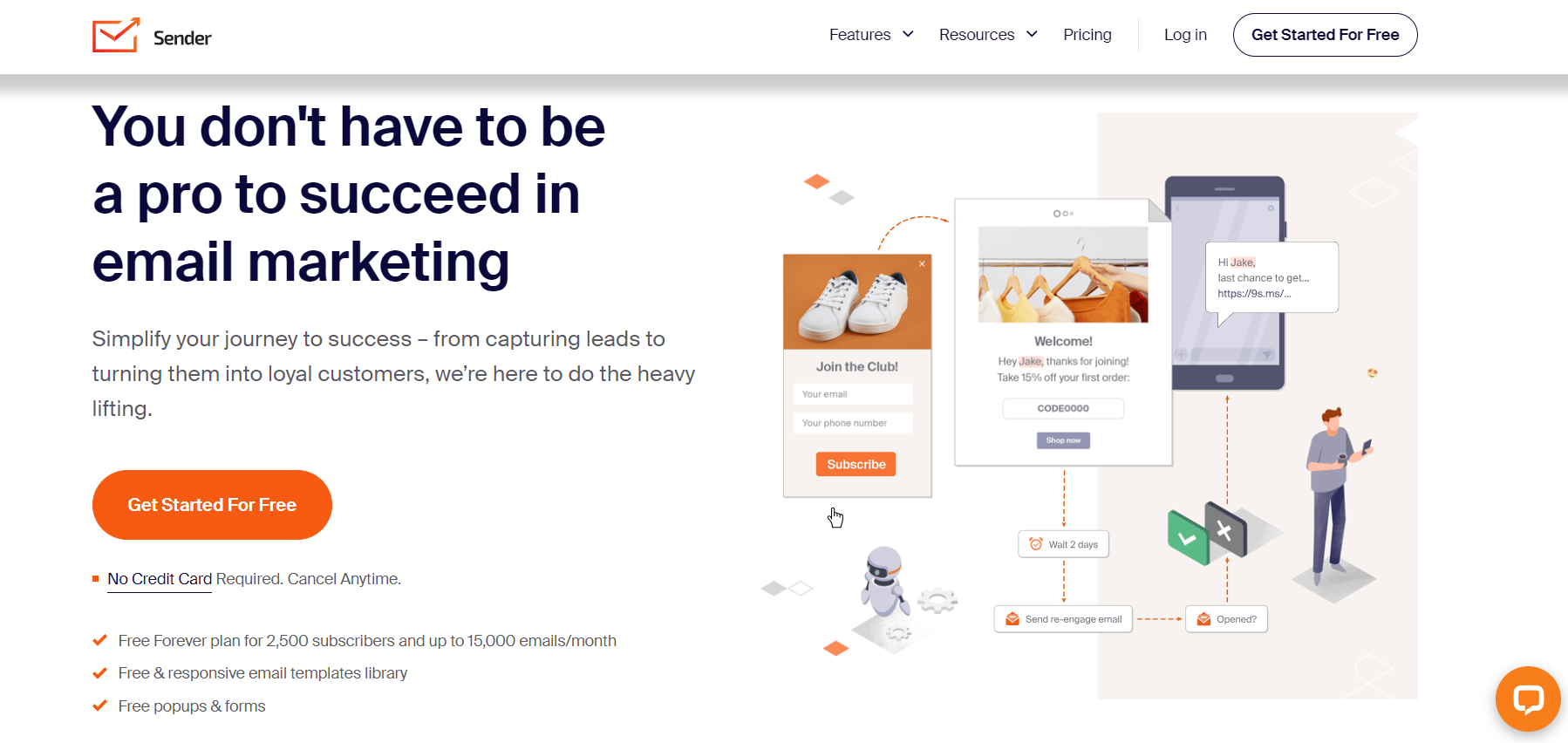
Sender stands out as a versatile newsletter platform that caters to a broad range of marketing needs. With its focus on delivering a seamless user experience and powerful features, Sender is an excellent choice for businesses aiming to enhance their email marketing strategies in 2024.
Key Features
- User-Friendly Email Builder: Sender’s drag-and-drop email builder makes it easy to create visually appealing newsletters without any coding knowledge. You can customize templates or start from scratch, ensuring your emails reflect your brand’s identity.
- Robust Automation: With Sender, you can set up automated email sequences based on user actions, such as welcome emails, birthday wishes, and follow-ups. This automation saves you time and ensures your audience receives timely communications.
- Advanced Analytics: The platform offers in-depth analytics that go beyond basic open and click rates. You can track user behavior over time, helping you refine your strategy and improve engagement.
- Integrations: Sender integrates with various third-party applications, including popular eCommerce platforms like WooCommerce and Shopify, making it easy to manage customer data and marketing efforts in one place.
Unique Feature: One standout aspect of Sender is its dynamic content feature, which allows you to customize parts of your email based on user data. This level of personalization can significantly enhance engagement and conversion rates.
Pricing
Sender offers an attractive pricing structure that makes it accessible for businesses of all sizes:
- Free Plan: Up to 2,500 subscribers and 15,000 emails per month.
- Paid Plans: Start at $10/month, providing access to more advanced features and larger subscriber limits.
Ease of Use
Sender is known for its intuitive interface, making it easy for newcomers to get started. Its well-organized dashboard and helpful tutorials ensure you can quickly learn how to leverage its full capabilities.
Pros & Cons
Pros:
- Highly customizable email builder with a range of templates.
- Strong automation capabilities that save time and boost efficiency.
- Dynamic content feature for improved personalization.
Cons:
- Some users report that the customer support response time could be improved.
- While robust, certain advanced features may require a learning curve for complete mastery.
#4 Flodesk
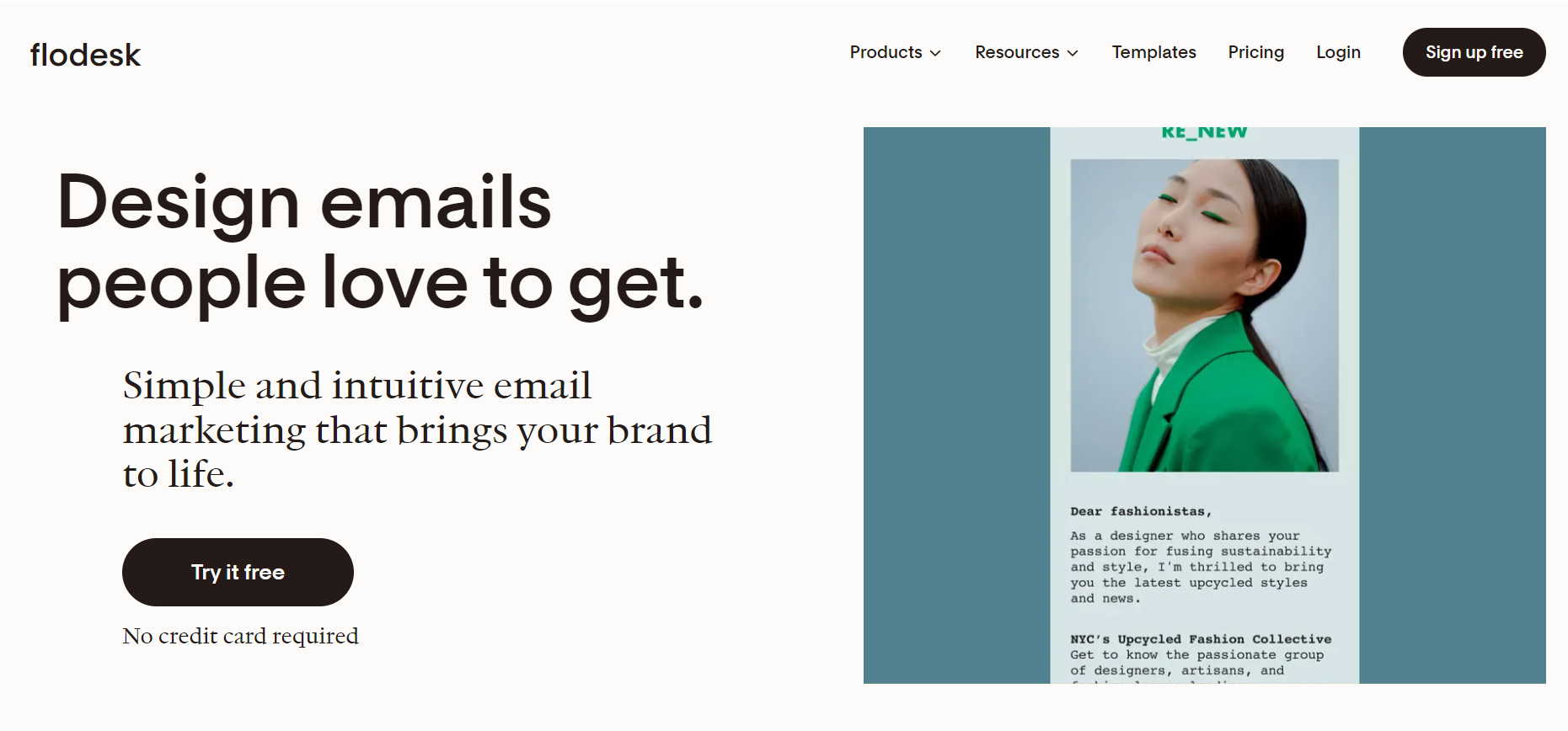
Flodesk has carved a niche for itself as the go-to platform for users who prioritize design without sacrificing functionality. Known for its beautiful email templates and straightforward user experience, Flodesk is perfect for creatives and small businesses looking to make a visual impact with their newsletters in 2024.
Key Features
- Stunning Templates: Flodesk offers a library of professionally designed templates that are fully customizable. Whether you’re announcing a new product or sharing a newsletter, you can easily create eye-catching emails that stand out in crowded inboxes.
- Visual Automation Builder: The platform’s visual workflow builder allows you to set up automated email sequences intuitively. You can create complex workflows using simple drag-and-drop actions, making automation feel accessible for all users.
- Forms & Landing Pages: Flodesk provides customizable forms and landing pages, enabling you to grow your email list effortlessly. You can embed forms on your website or use standalone landing pages to capture leads.
- Unlimited Sending: Unlike many competitors, Flodesk does not limit the number of emails you can send, making it an attractive option for businesses with varying email frequencies.
Unique Feature: Flodesk’s customizable forms not only capture email addresses but also allow you to collect additional information about subscribers, enabling you to segment your audience more effectively.
Pricing
Flodesk offers a simple, flat-rate pricing model:
- Flat Rate: $38/month for unlimited subscribers and emails, making it a budget-friendly option for growing businesses.
Ease of Use
Flodesk is designed with ease of use in mind. The intuitive interface and minimalistic design ensure that even those who are not tech-savvy can create and manage their email campaigns without a hitch.
Pros & Cons
Pros:
- Exceptional design capabilities with a focus on aesthetics.
- Unlimited sending with a straightforward pricing model.
- User-friendly interface that simplifies campaign creation.
Cons:
- Lacks some advanced analytics features compared to competitors.
- Limited integrations with third-party tools, may be a drawback for businesses using various software.
#5 Moosend
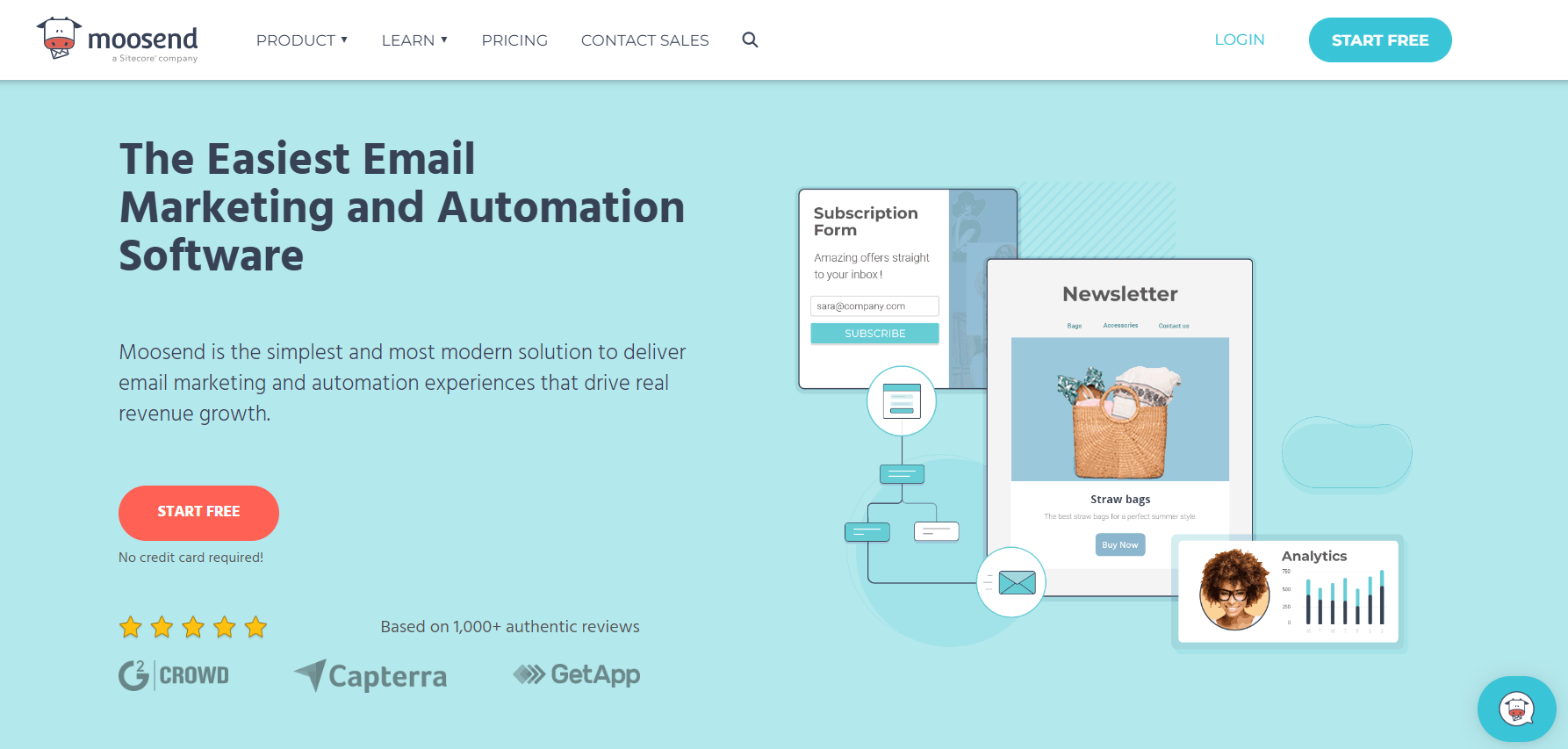
Moosend has gained recognition as a comprehensive email marketing platform that delivers powerful features in a user-friendly package. Ideal for businesses seeking an all-in-one solution, Moosend combines email marketing with automation, landing pages, and detailed analytics, making it a top choice for marketers in 2024.
Key Features
- Email Campaign Builder: Moosend’s intuitive drag-and-drop email builder allows users to create stunning emails easily. With a variety of customizable templates, you can quickly design professional newsletters that align with your brand.
- Advanced Automation: The platform offers sophisticated automation workflows, enabling you to set triggers based on user interactions, such as email opens and clicks. This helps you send timely and relevant messages to your audience.
- Segmentation and Targeting: Moosend allows you to segment your audience effectively, ensuring your campaigns reach the right people. You can create segments based on demographics, behavior, and more, enhancing your targeting efforts.
- Detailed Analytics: Gain insights into your campaigns with Moosend’s robust analytics dashboard. Track key metrics like open rates, click-through rates, and subscriber activity to measure your success and refine your strategy.
Unique Feature: Moosend’s AI-driven recommendations can optimize your campaigns by suggesting the best times to send emails, as well as recommending content types that resonate with your audience.
Pricing
Moosend’s pricing is competitive, with a focus on offering value:
- Free Plan: Up to 1,000 subscribers and unlimited emails, which is great for startups and small businesses.
- Paid Plans: Start at $10/month for additional features and larger subscriber limits.
Ease of Use
Moosend is designed for both beginners and experienced marketers. The clean interface and helpful tutorials make it easy to get started and effectively utilize all the platform’s features.
Pros & Cons
Pros:
- Comprehensive feature set that covers all aspects of email marketing.
- Generous free plan suitable for smaller businesses.
- AI-driven insights that help improve campaign performance.
Cons:
- Some users may find the reporting features less robust compared to larger platforms.
- The automation interface, while powerful, may take time to master for more complex workflows.
#6 Ghost
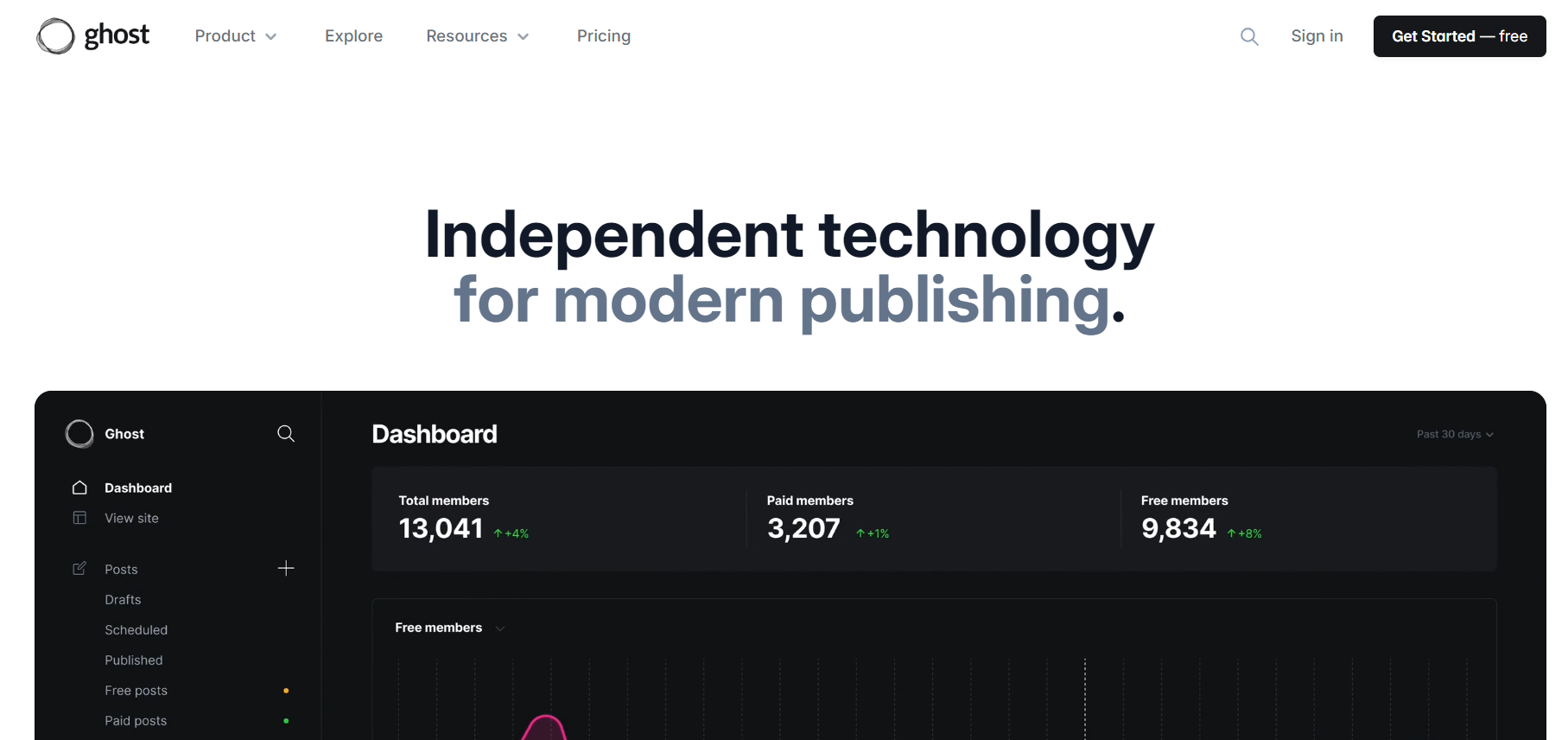
Ghost is transforming the way content creators and businesses approach email marketing by combining newsletter functionality with a powerful publishing platform. Designed specifically for writers, bloggers, and content marketers, Ghost enables you to build a community around your content while engaging your audience through targeted newsletters in 2024.
Key Features
- Integrated Blogging and Newsletter: Ghost seamlessly integrates blog and newsletter functionalities, allowing you to publish articles and send newsletters from the same platform. This integration simplifies content management and audience engagement.
- Membership and Subscription Tools: Ghost offers robust membership features, enabling you to create subscriber-only content. This is ideal for creators looking to monetize their audience through paid memberships.
- Customizable Themes: With a range of themes and customization options, Ghost allows you to create a unique look and feel for your newsletters and website. You don’t need extensive coding skills to make it your own.
- Built-in SEO and Analytics: Ghost includes powerful SEO tools and analytics to track engagement metrics. Understanding your audience’s behavior can help you refine your content strategy and grow your subscriber base.
Unique Feature: One of Ghost’s standout features is its focus on community engagement. You can create a membership model that encourages users to subscribe for exclusive content, turning your newsletter into a valuable resource.
Pricing
Ghost operates on a subscription model:
- Basic Plan: Starts at $9/month for individuals and small businesses, offering essential features for newsletter management and publishing.
- Business Plan: Starts at $29/month for advanced features, including membership management and enhanced customization options.
Ease of Use
Ghost is designed with creators in mind, featuring an intuitive interface that makes it easy to publish content and manage newsletters. Whether you’re a seasoned marketer or a beginner, you’ll find Ghost’s user-friendly design welcoming.
Pros & Cons
Pros:
- Integrated blogging and newsletter capabilities for cohesive content management.
- Strong membership features for monetizing your audience.
- Customizable themes and robust SEO tools.
Cons:
- May require a bit of a learning curve for those new to content management systems.
- Limited integration options compared to other platforms focused solely on email marketing.
#7 Substack
Substack has emerged as a favorite for independent writers and creators seeking to build their audience and monetize their content. With its straightforward approach and focus on newsletters, Substack is perfect for those looking to share their ideas and connect with readers directly in 2024.
Key Features
- User-Friendly Interface: Substack offers an incredibly simple and clean interface, making it easy for writers to set up their newsletters and start publishing right away. You don’t need any technical skills to get started.
- Built-In Monetization: One of Substack’s key features is its built-in monetization options. Writers can easily set up paid subscriptions, allowing them to charge readers for exclusive content while still offering free options for broader engagement.
- Email Distribution: Every post you create is automatically sent to your subscribers via email, ensuring your content reaches them directly in their inbox without needing extra steps.
- Community Engagement: Substack fosters community by allowing writers to interact with subscribers through comments, making it a great platform for building relationships with your audience.
Unique Feature: Substack’s focus on long-form content allows creators to publish detailed articles, essays, or stories that can engage readers on a deeper level, a feature not often prioritized in traditional email marketing platforms.
Pricing
Substack has a straightforward pricing structure:
- Free to Start: Writers can use Substack for free and keep 100% of their subscription revenue from paid subscribers.
- No Upfront Costs: Substack only takes a 10% cut of the revenue from paid subscriptions, making it an attractive option for new creators looking to monetize without initial costs.
Ease of Use
The platform is incredibly intuitive. Writers can focus on content creation rather than technical setups, allowing them to spend more time crafting their messages and engaging with their audience.
Pros & Cons
Pros:
- Simple setup with no technical skills required.
- Built-in monetization features to generate income.
- Strong focus on community and reader engagement.
Cons:
- Limited design customization options compared to other platforms.
- Primarily focused on text-based content, which may not suit all businesses.
#8 Mailmodo
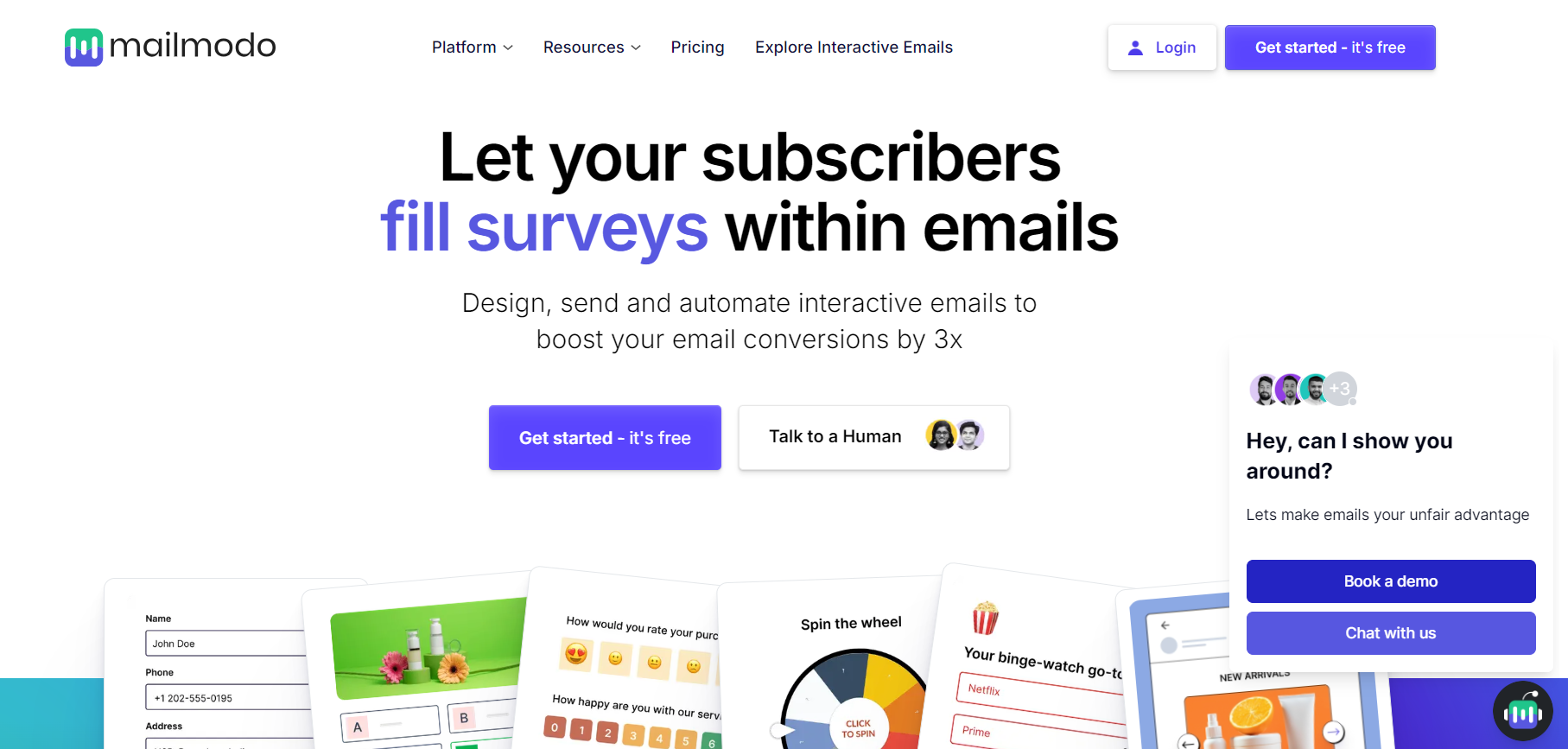
Mailmodo is revolutionizing the email marketing landscape by focusing on creating interactive email experiences. In 2024, this platform stands out by allowing marketers to engage their audience more deeply through dynamic content and immersive features.
Key Features
- AMP for Email: Mailmodo utilizes AMP (Accelerated Mobile Pages) technology to create interactive emails. This means subscribers can engage directly within the email, whether filling out forms, booking appointments, or completing surveys without leaving their inbox.
- Drag-and-Drop Editor: The platform features an easy-to-use drag-and-drop editor, making it simple for marketers to design interactive emails that captivate their audience.
- Pre-built Templates: Mailmodo provides a variety of pre-designed templates specifically optimized for interactivity, allowing users to create engaging content quickly.
- Segmentation and Personalization: With robust segmentation options, Mailmodo enables marketers to send personalized emails based on subscriber behavior and preferences, significantly enhancing engagement rates.
Unique Feature: The interactive form capability allows users to collect data directly from emails, turning passive email reading into an active engagement opportunity.
Pricing
Mailmodo’s pricing is flexible and designed to cater to various business sizes:
- Free Plan: Up to 1,000 subscribers and 5,000 emails per month.
- Paid Plans: Start at $9/month for additional features and higher sending limits.
Ease of Use
Mailmodo is designed to be accessible to all users, regardless of technical expertise. The intuitive interface and comprehensive guides make it easy for marketers to create and send interactive emails effectively.
Pros & Cons
Pros:
- Innovative use of AMP technology for interactive emails.
- User-friendly editor with pre-built templates for quick campaign creation.
- Strong segmentation and personalization capabilities.
Cons:
- Some users may experience limitations with the free plan.
- The focus on interactivity may require users to adjust their email strategies.
#9 Aweber
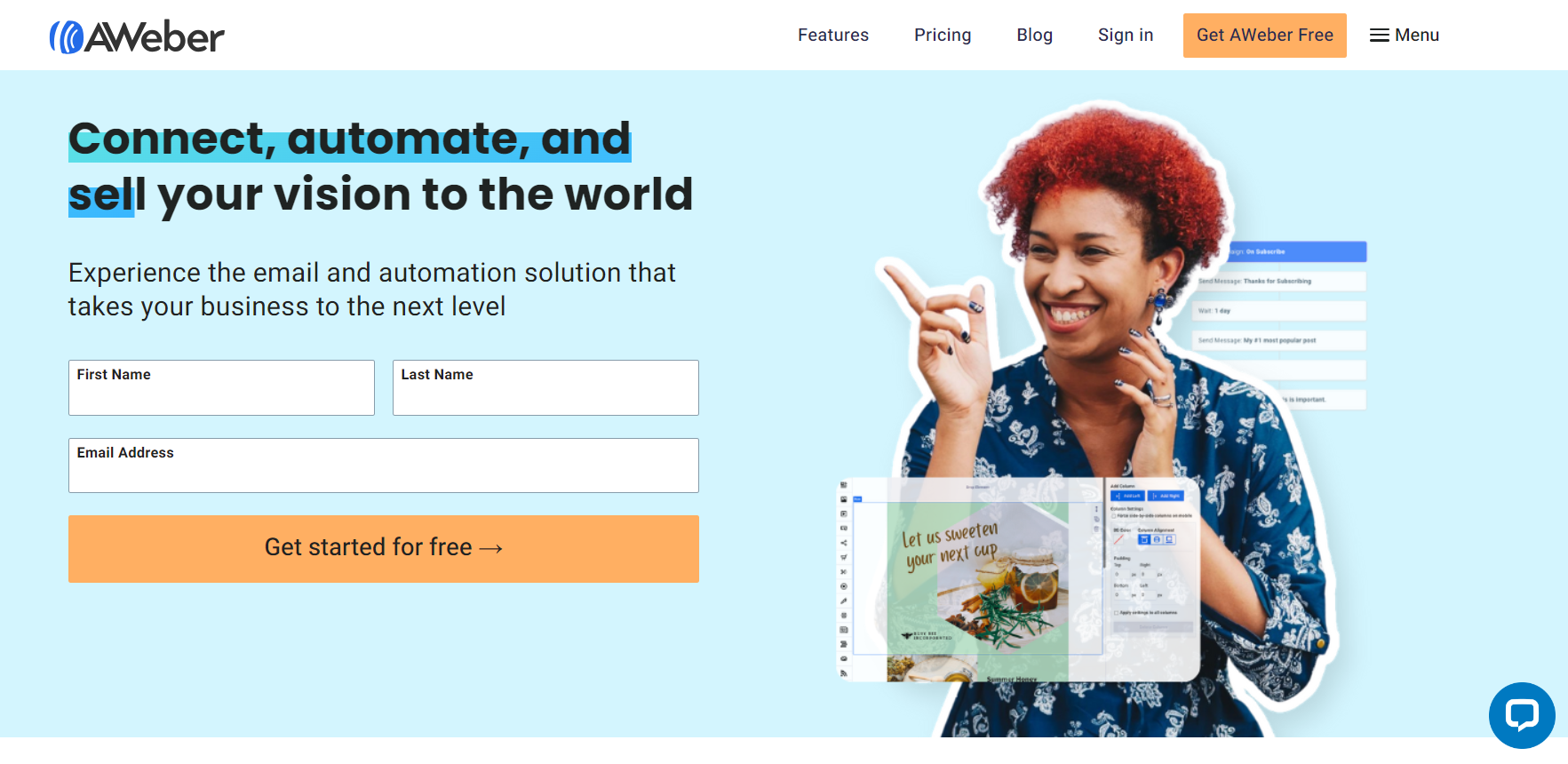
Aweber has been a trusted name in email marketing for many years, known for its robust features and reliable service. As a veteran in the industry, Aweber continues to adapt and innovate, making it a solid choice for businesses looking for a comprehensive email marketing solution in 2024.
Key Features
- Email Automation: Aweber offers powerful automation capabilities, allowing users to create sophisticated email workflows based on subscriber behavior. You can set triggers for welcome emails, follow-ups, and more, ensuring timely and relevant communication.
- Extensive Template Library: The platform provides a wide range of professionally designed email templates that cater to various industries and purposes. This makes it easy to create visually appealing emails without starting from scratch.
- List Segmentation: Aweber allows you to segment your subscriber lists based on behavior, demographics, and interests, enabling more targeted campaigns that resonate with your audience.
- A/B Testing: With built-in A/B testing features, Aweber lets you experiment with different subject lines, content, and sending times to optimize your campaigns for maximum engagement.
Unique Feature: Aweber’s integrated landing page builder allows you to create dedicated landing pages for your campaigns, making it easier to capture leads and grow your subscriber list without needing additional tools.
Pricing
Aweber’s pricing is competitive, with plans designed to accommodate various business needs:
- Free Plan: Up to 500 subscribers and 3,000 emails per month, ideal for startups and small businesses.
- Paid Plans: Start at $19/month for unlimited emails and access to advanced features.
Ease of Use
Aweber is known for its user-friendly interface, making it easy for both beginners and experienced marketers to navigate the platform. The comprehensive support resources, including tutorials and webinars, further enhance the user experience.
Pros & Cons
Pros:
- Strong automation and segmentation capabilities.
- Extensive library of email templates to choose from.
- A long-standing reputation in the email marketing industry.
Cons:
- Some users may find the pricing structure less competitive at higher subscriber counts.
- The interface, while user-friendly, may feel a bit dated compared to newer platforms.
Conclusion: Choosing the Right Newsletter Platform
With so many newsletter platforms available, it can be challenging to determine the best option for your needs. By carefully considering factors such as your audience, budget, and desired features, you can choose a platform that empowers you to create effective and engaging newsletters.
Here’s a quick recap of the top 9 platforms we’ve discussed:
- MailerLite: User-friendly interface, a wide range of features, pop-up builder.
- Kit: Focus on design and simplicity, pre-designed templates, and AI-powered suggestions.
- Sender: Affordable, focus on deliverability, wide range of features.
- Flodesk: Simple and intuitive interface, focus on design, Flodesk Academy.
- Moosend: Comprehensive platform, transactional email functionality.
- Ghost: Focus on content creation and publishing, newsletter functionality.
- Substack: Platform for creators and writers, monetization options.
- Mailmodo: Interactive email functionality, a wide range of features.
- AWeber: Established platform, can-spam compliance checker.
Ultimately, the best platform for you will depend on your specific needs and preferences. Consider your audience, budget, and desired features before making a decision.
Remember: A great newsletter platform is just one piece of the puzzle. To truly succeed, you’ll also need to create high-quality content, build a strong email list, and engage with your subscribers.
Important Note:- The platforms we’ve discussed may have updates and pricing changes, and while we strive for accuracy, mistakes can happen. If you find any incorrect information, please let us know in the comments, and we’ll correct it. 😊

